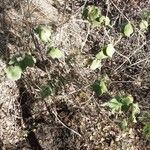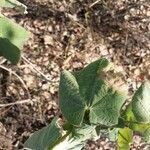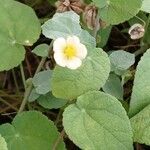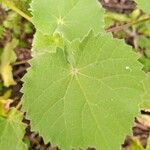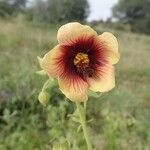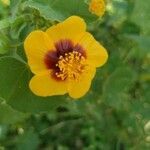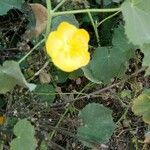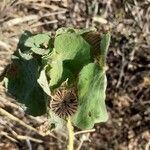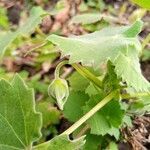Large erect herb to soft-stemmed shrub up to about 1·5 m. tall, covered on young parts, stems, petioles, pedicels and calyx with a dense usually somewhat yellowish or brownish usually velutinous occasionally somewhat harsh stellate-tomentose indumentum intermingled on young parts, especially the tips of the branches, with short glandular hairs, and usually on younger parts of stems, petioles and pedicels also with long patent white or yellow hairs, the latter more rarely very scanty; stems terete, the older portions usually stout, at length glabrescent, slightly lignified with a large pith, covered with a thin greyish-brown cortex with close lanceolate-rhomboid to linear markings (shallow fissures or lenticels) often forming an almost continuous pattern.
Leaf-lamina 4–20 cm. long and up to 18 cm. broad, suborbicular-cordate or broadly ovate-cordate, generally drying a yellowish or brownish-green colour, usually markedly acuminate with a narrow mucronate acumen, irregularly and distinctly to coarsely serrate or serrate-crenate to biserrate, occasionally very slightly 3-lobed; finely and harshly stellate-pubescent, glabrescent, somewhat rough to the touch, often also with sessile glands (hence viscid) on the upper surface, more densely and more softly stellate-pubescent and with prominent veins on the slightly paler lower surface; petiole generally as long as or longer than the corresponding lamina, terete.
Soft-stemmed shrub or herb, 1.5 m high. Young parts viscid; indumentum of stems stellate-velvety usually intermingled with sparse longer patent hairs and with dense amber-coloured glandular hairs. Mericarps mu-ticous or occasionally mucronate. Flowers yellow often with reddish centre or red venation.
A herb or small shrub. It grows 0.5-2 m high. It has clammy hairs. The leaf stalks are 3-15 cm long. The leaves are sword shaped and 4-18 cm long. There are hairs on both surfaces. The flowers occur singly in the axils of leaves. The fruit have 2-3 seeds. They are kidney shaped and 2-2.5 mm across.
Flowers yellow, often with a reddish centre, and/or the venation reddish towards the centre, axillary, on main branches and sometimes also on short lateral shoots and often forming a terminal leafy panicle; pedicels up to about 5 cm. long, articulated in upper 11 mm.
Fruit 12–15 × c. 20 mm., depressed-globose, broadly and shallowly umbilicate, densely and shortly stellate-pubescent, nearly enclosed by the accrescent up to 14 mm. long appressed fruiting calyx.
Calyx 8–10 mm. long, campanulate, strigose-tomentose inside, divided about half-way down; lobes triangular-ovate, acute to shortly apiculate, ciliate.
Mericarps 20–30, dorsally rounded, usually bluntly angled and muticous to shortly pointed near the dorsal (outer) upper side.
Seeds 2–3, verruculose and usually distinctly but finely stellate-pubescent.
Staminal tube stellate-hairy.
Petals c. 16 mm. long.
